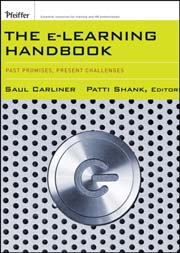
In this book, original contributions from the worlds foremost e-learning experts provide a comprehensive and ‘state-of-the-art’ look at the economic, technological, design, economic, evaluation, research, and philosophical issues of e-learning. Data-driven, critical, and prescriptive, this book is a up-to-dateand timely reference for all e-learning stakeholders and decision-makers in for-profit, non-profit, and educational settings. It explores issues of deep concern to practicing professionals, including standards, technology integration, learning objects, and business success. INDICE: Preface. Introduction. PART I: THE CONTEXT FOR E-LEARNING. Chapter1. Thinking Critically to Move e-Learning Forward (Patti Shank). PART II: THEREALITY VERSUS THE HYPE OF E-LEARNING. Chapter 2. Hype Versus Reality in the Boardroom: Why e-Learning Hasnt Lived Up to Its Initial Projections for Penetrating the Corporate Environment (Margaret Driscoll). Chapter 3. Hype Versus Reality on Campus: Why e-Learning Isnt Likely to Replace a Professor Any Time Soon (Brent G. Wilson and Lee Christopher). Chapter 4. Knowledge Management: From the Graveyard of Good Ideas (William Horton). PART III: TECHNOLOGY ISSUES. Chapter 5. Infrastructure for Learning: Options for Today or Screw-Ups for Tomorrow (Patti Shank, L. Wayne Precht, Harvey Singh, Jim Everidge, and Jane Bozarth). Chapter 6. e-Learning Standards: A Framework for Enabling the Creation and Distribution of High-Quality, Cost-Effective Web-Delivered Instruction (Pat Brogan). Chapter 7. Learning with Objects (Patrick Parrish). Chapter 8. Web 2.0 and Beyond: The Changing Needs of Learners, New Tools, and Ways to Learn (Patti Shank). Chapter 9. Locked Out: Bridging the Divide Between Training and Information Technology (Marc J. Rosenberg and Steve Foreman). PART IV: DESIGN ISSUES. Chapter 10. A Holistic Framework of Instructional Design for e-Learning (Saul Carliner). Chapter 11. Converting e3-Learning to e3-Learning: An Alternative Instructional Design Method (M. David Merrill). Chapter 12. Design with the Learning in Mind (Patricia McGee). PART V: ISSUES OF THEORY AND RESEARCH. Chapter 13. Revisiting Learning Theory for e-Learning (Gretchen Lowerison, Roger Côté, Philip C. Abrami, and Marie-Claude Lavoie). Chapter 14. Design Research: A Better Approach to Improving Online Learning (Thomas C. Reeves, Jan Herrington, and Ron Oliver). PART VI: ECONOMIC ISSUES AND MOVING FORWARD. Chapter 15. Is e-Learning Economically Viable? (Patrick Lambe). Chapter 16. e-Learning:Todays Challenge, Tomorrows Reality (Saul Carliner). About the Editors. Aboutthe Contributors. Index.
- ISBN: 978-0-7879-7831-0
- Editorial: Jossey Bass
- Encuadernacion: Cartoné
- Páginas: 560
- Fecha Publicación: 07/05/2008
- Nº Volúmenes: 1
- Idioma: Inglés
